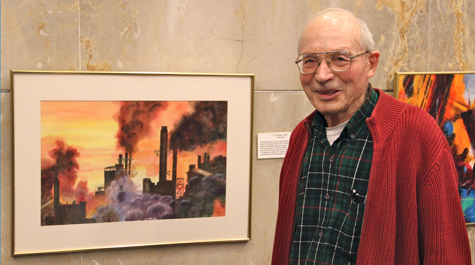by Erin Kelly
 A series of 22 paintings by Maynard Nichols, artist and emeritus professor at the Virginia Institute of Marine Science, are on exhibit in the Botetourt Gallery at Swem Library.
A series of 22 paintings by Maynard Nichols, artist and emeritus professor at the Virginia Institute of Marine Science, are on exhibit in the Botetourt Gallery at Swem Library.
The exhibit—aptly titled “Climate Change”—is a contribution from Nichols to W&M’s celebration of Earth Week, and focuses on the important issue of climate change and its impacts on the planet.
Nichols retired from VIMS in 1992 following a 32-year career studying the transport of sediments and pollutants in estuaries. His work had important and long-lasting implications for sand mining, flood-zone mapping, Kepone clean-up, and channel dredging and dredge disposal in Chesapeake Bay. Since his retirement, he has been active in the local art scene, exhibiting his Bayscape watercolors throughout the Tidewater region.
Nichols says the goal of his latest exhibit—which took two-and-a-half years to complete—was to translate scientific features and processes into fine art. His paintings document the entire process of climate change—from causative agents, to signs of change, to impacts and possible solutions.
“It’s important for me to convey the impacts of climate change through my artwork so I can try to show people that this is a serious problem that needs attention,” says Nichols. “I also want to see if translating science into fine art is useful in educating non-scientists.”
Nichols’ paintings combine a wide variety of sources, techniques, and media. The exhibit draws from photography, satellite imagery, scientific illustrations, and personal interpretations. “Multimedia paintings are like visual experiments that explore design and discover ideas through shape, color, and texture,” says Nichols. “My hope is that they will provide a visual journey, along with an educational experience.”
In addition to Nichols’ exhibit, artwork from other local artists is currently on display in the Botetourt Gallery as a part of an Earth Week art competition. All of the submissions in the contest were made using recycled materials and/or relate to sustainability in some way.
Earth Week is hosted each year by W&M’s Committee on Sustainability. This year, two student interns in the EcoAmbassador Internship Program joined with Patrick Foley, the College’s Sustainability Fellow, to plan the activities, including Nichols’ exhibit.
Foley is responsible for coordinating sustainability initiatives for W&M’s COS, and for promoting the College's sustainability goals. He works closely with students, faculty, and administrators on a wide variety of issues. Aiyana Bodi and Katie Thoma are this year’s EcoAmbassadors who were chosen by the COS to communicate the message of sustainability to various departments and offices on campus.
Bodi says that she believes art is a great way to convey a message, especially one that might not come across as that important to many people. “Dr. Nichols' exhibit is great because it tackles the topic of climate change—which is still controversial and not well-understood—and makes it accessible to the general public, hopefully making them more aware of the issue.”
W&M Earth Week 2014 runs from April 14th through the 19th. This year’s theme is the five senses, with each day of the week featuring activities that awaken one of the five senses—taste, smell, touch, sight, and hearing. For its part in Saturday’s grand finale celebration, W&M will join with Alma Mater Production to host “Homebrewaroo” from 11 a.m. to 3 p.m. in the Sunken Garden. The event will feature student organizations, local businesses, a petting zoo, music, food, and more.
“We're all really excited about this year’s celebration of Earth Week,” says Bodi. “We hope that it not only gets the attention of people already interested in the environment, but also those who may not know that much about these topics.”
Nichol’s exhibit—along with the art competition entries—will be on display in the Botetourt Gallery through May 19.
Pictured above: VIMS Emeritus Professor Maynard Nichols developed a passion and talent for painting following his 32-year career as a marine scientist.

